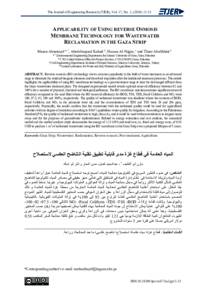Document
Applicability of using reverse osmosis membrane technology for wastewater reclamation in the Gaza Strip.
Identifier
DOI:10.24200/tjer.vol17iss1pp11-23
Source
The journal of engineering research (TJER), v. 17, no. 1, p. 11-23.
Contributors
Other titles
مدى قابلية تطبيق تقنية التناضح العكسي لاستصلاح المياه العادمة في قطاع غزة.
Country
Oman.
City
Muscat
Publisher
College of Engineering, Sultan Qaboos University.
Gregorian
2020
Language
English
English abstract
Reverse osmosis (RO) technology shows common popularity in the field of water treatment as an advanced stage to eliminate the residual biogenic elements and dissolved impurities after the traditional treatment processes. This article highlights the applicability of using RO membrane technology as a post-treatment stage to treat the discharged effluent from the Gaza wastewater treatment plant. The designed experimental model reveals optimal removal efficiency between 92 and 100% for a number of physical, chemical and biological pollutants. The RO membrane unit demonstrates significant removal efficiency compared to the sand filter where the RO removal efficiency for BOD, TSS, TDS, Fecal Coliform and NO3 were 100, 97.5, 92, 100 and 100%, respectively. The quality of reclaimed wastewater was idealistic where the contents of BOD, Fecal Coliform and NO3 in the permeate were nil, and the concentrations of TDS and TSS were 20 and 296 ppm, respectively. Practically, the results confirm that the wastewater with the reclaimed quality could be used for agricultural activities with no degree of restriction according to FAO’s guidelines water quality for irrigation. According to the Palestinian Standard (PS), the quality of reclaimed wastewater is high, class (A), and it could be used without restrictions to irrigate many crops and for the purposes of groundwater replenishment. Related to energy estimation and cost analysis, the numerical model and the market analysis study demonstrate the energy of 1.23 kWh and total cost, i.e. fixed and energy costs, of 0.58 USD to produce 1 m³ of reclaimed wastewater using the RO membrane in the Gaza Strip over a projected lifespan of 5 years.
ISSN
Online: 1726-6742
Print: 1726-6009
Arabic abstract
في ضوء التطور السريع في تكنولوجيا معالجة المياه، أصبح توجه استصلاح المياه العادمة خياراً واعداً لتخفيف أزمة المياه وزيادة الاستدامة في نظام إدارة المياه في المناطق التي تعاني عجزاً حقيقياً في مصادر المياه. تكنولوجيا التناضح العكسي تشكل التقنية الأكثر رواجاً في مجال معالجة المياه وإزالة العوالق والملوثات البيولوجية وغيرها. نسلط الضوء في هذا المقال على استخدام أغشية التناضح العكسي لمعالجة المياه العادمة الخارجة من محطة غزة للمياه العادمة، وذلك للوصول إلى مياه قابلة للاستخدام في مجال الزراعة وحقن الخزان الجوفي حسب المعايير الفلسطينية للمياه. أظهر النموذج المصمم باستخدام أغشية التناضح العكسي كفاءة تتراوح بين 92% إلى 100% في إزالة الملوثات الفيزيائية والكيميائية والبيولوجية. وكانت كفاءة إزالة BOD، TSS، TDS، Fecal Coliform، وNO₃ على التوالي 100%، 97.5%، 92%، 100%، و100%. عملياً يمكن الاستنتاج أن جودة المياه المعالجة بهذه التقنية يمكن تصنيفها بدرجة (A) حسب المعايير الفلسطينية، مما يعني أنه يمكن استخدامها بدون محددات في الزراعة والري وحقن الخزان الجوفي. من ناحية أخرى، أظهرت النتائج أن كمية الطاقة اللازمة يومياً هي 1.23 كيلو وات لكل متر مكعب، وتبلغ تكلفة معالجة المتر المكعب 0.58 دولار أمريكي حساباً على فترة عمر 5 سنوات للمشروع.
Category
Journal articles

